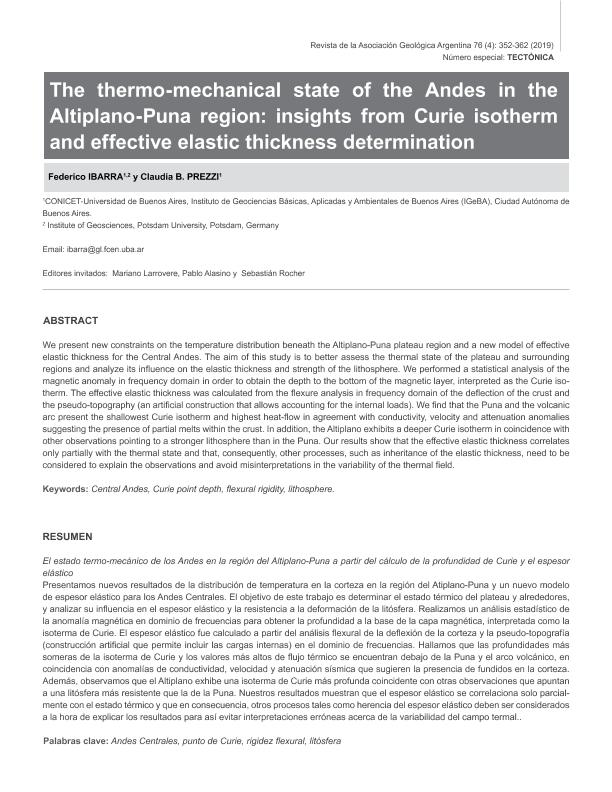Artículo
Presentamos nuevos resultados de la distribución de temperatura en la corteza en la región del Atiplano-Puna y un nuevo modelo de espesor elástico para los Andes Centrales. El objetivo de este trabajo es determinar el estado térmico del plateau y alrededores, y analizar su influencia en el espesor elástico y la resistencia a la deformación de la litósfera. Realizamos un análisis estadístico de la anomalía magnética en dominio de frecuencias para obtener la profundidad a la base de la capa magnética, interpretada como la isoterma de Curie. El espesor elástico fue calculado a partir del análisis flexural de la deflexión de la corteza y la pseudo-topografía (construcción artificial que permite incluir las cargas internas) en el dominio de frecuencias. Hallamos que las profundidades más someras de la isoterma de Curie y los valores más altos de flujo térmico se encuentran debajo de la Puna y el arco volcánico, en coincidencia con anomalías de conductividad, velocidad y atenuación sísmica que sugieren la presencia de fundidos en la corteza. Además, observamos que el Altiplano exhibe una isoterma de Curie más profunda coincidente con otras observaciones que apuntan a una litósfera más resistente que la de la Puna. Nuestros resultados muestran que el espesor elástico se correlaciona solo parcialmente con el estado térmico y que en consecuencia, otros procesos tales como herencia del espesor elástico deben ser considerados a la hora de explicar los resultados para así evitar interpretaciones erróneas acerca de la variabilidad del campo termal. We present new constraints on the temperature distribution beneath the Altiplano-Puna plateau region and a new model of effective elastic thickness for the Central Andes. The aim of this study is to better assess the thermal state of the plateau and surrounding regions and analyze its influence on the elastic thickness and strength of the lithosphere. We performed a statistical analysis of the magnetic anomaly in frequency domain in order to obtain the depth to the bottom of the magnetic layer, interpreted as the Curie isotherm. The effective elastic thickness was calculated from the flexure analysis in frequency domain of the deflection of the crust and the pseudo-topography (an artificial construction that allows accounting for the internal loads). We find that the Puna and the volcanic arc present the shallowest Curie isotherm and highest heat-flow in agreement with conductivity, velocity and attenuation anomalies suggesting the presence of partial melts within the crust. In addition, the Altiplano exhibits a deeper Curie isotherm in coincidence with other observations pointing to a stronger lithosphere than in the Puna. Our results show that the effective elastic thickness correlates only partially with the thermal state and that, consequently, other processes, such as inheritance of the elastic thickness, need to be considered to explain the observations and avoid misinterpretations in the variability of the thermal field.
The thermo-mechanical state of the Andes in the Altiplano-Puna region: insights from Curie isotherm and effective elastic thickness determination
Título:
El estado termo-mecánico de los Andes en la región del Altiplano-Puna a partir del cálculo de la profundidad de Curie y el espesor elástico
Fecha de publicación:
10/2019
Editorial:
Asociación Geológica Argentina
Revista:
Revista de la Asociación Geológica Argentina
ISSN:
1669-7316
e-ISSN:
1851-8249
Idioma:
Inglés
Tipo de recurso:
Artículo publicado
Clasificación temática:
Resumen
Palabras clave:
CENTRAL ANDES
,
CURIE POINT DEPTH
,
FLEXURAL RIGIDITY
,
LITHOSPHERE
Archivos asociados
Licencia
Identificadores
Colecciones
Articulos(IGEBA)
Articulos de INSTITUTO DE GEOCIENCIAS BASICAS, APLICADAS Y AMBIENTALES DE BS. AS
Articulos de INSTITUTO DE GEOCIENCIAS BASICAS, APLICADAS Y AMBIENTALES DE BS. AS
Citación
Ibarra, Federico; Prezzi, Claudia Beatriz; The thermo-mechanical state of the Andes in the Altiplano-Puna region: insights from Curie isotherm and effective elastic thickness determination; Asociación Geológica Argentina; Revista de la Asociación Geológica Argentina; 76; 4; 10-2019; 352-362
Compartir




